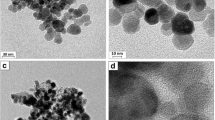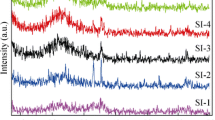Abstract
The current study involves the synthesis of Lantana camara (LC)–incorporated mesostructured iron nanoparticles for the removal of nickel ions from aqueous solution. By systematically varying the operational parameters such as metal ion concentration, pH, adsorbent dosage, contact time, and temperature, the desirable conditions of adsorption were determined. The favorable adsorption at higher temperatures implies that the system is exhibiting endothermic reactions and the Van’t Hoff plot suggested the spontaneous and feasible nature of the adsorption process. Another key point is the fast kinetics of the sorption process that occurred in the first 10 min of sorption processes. Among the kinetic models investigated, the sorption is better explained by pseudo-second-order model favoring chemical adsorption. Furthermore, the complexation of nickel ions with –COOH groups of the LC nanoparticles are confirmed in the FTIR studies and the mesoporous (162.1 A°) nature of nanoparticles are confirmed in the BET analysis. From the VSM analysis, the superparamagnetic nature of the mesoporous nanoparticles were revealed. Another important finding from the VSM results is the high saturation magnetization (66.9 emu/g) of the nanoparticles. Equally important is desorption studies where a maximum efficiency of 81% is obtained using 05 N HCl. With the help of the Langmuir modeling studies, the possible mechanism of sorption are explained and more importantly the monolayer adsorption capacity from the model was found to be 133 mg/g.
Graphical abstract












Similar content being viewed by others
References
Bhattacharya K, Parasar D, Mondal B, Deb P (2015) Mesoporous magnetic secondary nanostructures as versatile adsorbent for efficient scavenging of heavy metals. Nat Publ Gr 5:1–9. https://doi.org/10.1038/srep17072
Malkoc E, Nuhoglu Y (2006) Removal of Ni(II) ions from aqueous solutions using waste of tea factory: adsorption on a fixed-bed column. J Hazard Mater 135:328–336. https://doi.org/10.1016/j.jhazmat.2005.11.070
Venkateswarlu S, Yoon M (2015) Rapid removal of cadmium ions using green-synthesized Fe3O4 nanoparticles capped with diethyl-4-(4 amino-5-mercapto-4H-1,2,4-triazol-3-yl)phenyl phosphonate. RSC Adv 5:65444–65453. https://doi.org/10.1039/C5RA10628A
Adegoke HI, AmooAdekola F, Fatoki OS, Ximba BJ (2014) Adsorption of Cr (VI) on synthetic hematite (??-Fe2O3) nanoparticles of different morphologies. Korean J Chem Eng 31:142–154. https://doi.org/10.1007/s11814-013-0204-7
Ewecharoen A, Thiravetyan P, Nakbanpote W (2008) Comparison of nickel adsorption from electroplating rinse water by coir pith and modified coir pith. 137:181–188. https://doi.org/10.1016/j.cej.2007.04.007
Kumar R, Mudhoo A, Lofrano G, Chandra M (2014) Journal of Environmental Chemical Engineering Biomass-derived biosorbents for metal ions sequestration : Adsorbent modification and activation methods and adsorbent regeneration. J Environ Chem Eng 2:239–259. https://doi.org/10.1016/j.jece.2013.12.019
Wen T, Wang J, Yu S, Chen Z, Hayat T, Wang X (2017) Magnetic porous carbonaceous material produced from tea waste for efficient removal of As ( V ), Cr ( VI ), humic acid and dyes The full mailing address of all authors : doi: https://doi.org/10.1021/acssuschemeng.7b00418, 5, 4371, 4380
Mthombeni NH, Onyango MS, Aoyi O (2015) Adsorption of hexavalent chromium onto magnetic natural zeolite-polymer composite. J Taiwan Inst Chem Eng 50:242–251. https://doi.org/10.1016/j.jtice.2014.12.037
Amarasinghe BMWPK, Williams RA (2007) Tea waste as a low cost adsorbent for the removal of Cu and Pb from wastewater. Chem Eng J 132:299–309. https://doi.org/10.1016/j.cej.2007.01.016
Bharathi KS, Ramesh SPT (2013) Fixed-bed column studies on biosorption of crystal violet from aqueous solution by Citrullus lanatus rind and Cyperus rotundus. Appl Water Sci 3:673–687. https://doi.org/10.1007/s13201-013-0103-4
Doan HD, Lohi A, Dang VBH, Dang-vu T (2008) Removal of Zn + 2 and Ni + 2 by adsorption in a fixed bed of wheat straw. 6:259–267. https://doi.org/10.1016/j.psep.2008.04.004
Kumar PS, Ramalingam S, Kirupha SD, Murugesan A, Vidhyadevi T, Sivanesan S (2011) Adsorption behavior of nickel ( II ) onto cashew nut shell : Equilibrium , thermodynamics , kinetics , mechanism and process design. Chem Eng J 167:122–131. https://doi.org/10.1016/j.cej.2010.12.010
Moussavi G, Barikbin B (2010) Biosorption of chromium(VI) from industrial wastewater onto pistachio hull waste biomass. Chem Eng J 162:893–900. https://doi.org/10.1016/j.cej.2010.06.032
Nirmala G, Murugesan T, Rambabu K, Sathiyanarayanan K, Show PL (2021) Adsorptive removal of phenol using banyan root activated carbon. Chem Eng Commun 208(6):831–842. https://doi.org/10.1080/00986445.2019.1674839
Rambabu K, Bharath G, Banat F, Show PL (2021a) Green synthesis of zinc oxide nanoparticles using Phoenix dactylifera waste as bioreductant for effective dye degradation and antibacterial performance in wastewater treatment. J Hazard Mater 402:123560
Rambabu K, Thanigaivelan A, Bharath G, Sivarajasekar N, Banat F, Show PL (2021b) Biosorption potential of Phoenix dactylifera coir wastes for toxic hexavalent chromium sequestration. Chemosphere 268:128809. https://doi.org/10.1016/j.chemosphere.2020.128809
Bhaumik M, Setshedi K, Maity A, Onyango MS (2013) Separation and purification technology chromium ( VI ) removal from water using fixed bed column of polypyrrole / Fe 3 O 4 nanocomposite. Sep Purif Technol 110:11–19. https://doi.org/10.1016/j.seppur.2013.02.037
Madhavi V, Prasad TNVKV, Vijaya A et al (2013) Spectrochimica Acta Part A : Molecular and biomolecular spectroscopy application of phytogenic zerovalent iron nanoparticles in the adsorption of hexavalent chromium. Spectrochim ACTA PART A Mol Biomol Spectrosc 116:17–25. https://doi.org/10.1016/j.saa.2013.06.045
Yoon S, Lee C, Park J et al (2014) Kinetic , equilibrium and thermodynamic studies for phosphate adsorption to magnetic iron oxide nanoparticles. Chem Eng J 236:341–347. https://doi.org/10.1016/j.cej.2013.09.053
Tandon PK, Shukla RC, Singh SB (2013) Removal of arsenic ( III ) from water with clay-supported zerovalent iron nanoparticles synthesized with the help of tea liquor
Balamurugan M (2014) Synthesis of iron oxide nanoparticles by using. Eucalyptus Globulus plant extract 12:363–367. https://doi.org/10.1380/ejssnt.2014.363
Ehrampoush MH, Miria M, Salmani MH, Mahvi AH (2015) Cadmium removal from aqueous solution by green synthesis iron oxide nanoparticles with tangerine peel extract. J Environ Health Sci Eng 13:1–7. https://doi.org/10.1186/s40201-015-0237-4
Nithya K, Sathish A, Kumar PS, Ramachandran T (2018) Journal of Industrial and Engineering Chemistry Fast kinetics and high adsorption capacity of green extract capped superparamagnetic iron oxide nanoparticles for the adsorption of Ni ( II ) ions. J Ind Eng Chem 59:230–241. https://doi.org/10.1016/j.jiec.2017.10.028
Pandey S, Mishra SB (2011) Organic-inorganic hybrid of chitosan/organoclay bionanocomposites for hexavalent chromium uptake. J Colloid Interface Sci 361(2):509–520. https://doi.org/10.1016/j.jcis.2011.05.031
Koriche Y, Darder M, Aranda P, Semsari S, Ruiz-Hitzky E (2014) Bionanocomposites based on layered silicates and cationic starch as eco-friendly adsorbents for hexavalent chromium removal. Dalton Trans 43(27):10512–10520. https://doi.org/10.1039/c4dt00330f
Ravikumar K, Udayakumar J (2020) Moringa oleifera biopolymer coagulation and bentonite clay adsorption for hazardous heavy metals removal from aqueous systems. Geosystem Engineering 23(5):265–275. https://doi.org/10.1080/12269328.2020.1778544
Nithya K, Sathish A, Kumar PS, Ramachandran T (2017) Functional group-assisted green synthesised superparamagnetic nanoparticles for the rapid removal of hexavalent chromium from aqueous solution. 1–9. doi: https://doi.org/10.1049/iet-nbt.2016.0259, 11, 852, 860
Zito P, Shipley HJ (2015) RSC Advances Inorganic nano-adsorbents for the removal of heavy metals and arsenic : a review. RSC Adv 5:29885–29907. https://doi.org/10.1039/C5RA02714D
Singh A, Bajpai J, Bajpai A (2014) Investigation of magnetically controlled water intake behavior of iron oxide impregnated superparamagnetic casein nanoparticles (IOICNPs). J Nanobiotechnology 12:38. https://doi.org/10.1186/s12951-014-0038-4
Sundaram PA, Augustine R, Kannan M (2012) Extracellular biosynthesis of iron oxide nanoparticles by Bacillus subtilis strains isolated from rhizosphere soil 840:835–840. https://doi.org/10.1007/s12257-011-0582-9
Venkateswarlu S, Rao YS, Balaji T, Prathima B, Jyothi NVV (2013) Biogenic synthesis of Fe3O4 magnetic nanoparticles using plantain peel extract. Mater Lett 100:241–244. https://doi.org/10.1016/j.matlet.2013.03.018
Nithya K, Sathish A, Senthil Kumar P, Ramachandran T (2016) Biosorption of hexavalent chromium from aqueous solution using raw and acid-treated biosorbent prepared from Lantana camara fruit. Desalin Water Treat 57:25097–25113. https://doi.org/10.1080/19443994.2016.1145605
Oliveira DQL, Gonçalves M, Oliveira LCA, Guilherme LRG (2008) Removal of As(V) and Cr(VI) from aqueous solutions using solid waste from leather industry. J Hazard Mater 151:280–284. https://doi.org/10.1016/j.jhazmat.2007.11.001
Shroff KA, Vaidya VK (2011) Kinetics and equilibrium studies on biosorption of nickel from aqueous solution by dead fungal biomass of Mucor hiemalis. Chem Eng J 171:1234–1245. https://doi.org/10.1016/j.cej.2011.05.034
Ebrahim SE, Sulaymon AH, Alhares HS (2015) Competitive removal of Cu , Cd , Zn , and Ni ions onto iron oxide nanoparticles from wastewater. doi: https://doi.org/10.1080/19443994.2015.1112310, 1, 15
Sharma SK, Mahiya S, Lofrano G et al (2015) Removal of divalent nickel from aqueous solutions using Carissa carandas and Syzygium aromaticum : isothermal studies and kinetic modelling. Appl Water Sci 7:1855–1868. https://doi.org/10.1007/s13201-015-0359-y
Dianchen D, Deng B, Lin L (2010) As ( III ) removal using an iron-impregnated chitosan sorbent. J Hazard Mater 182:156–161. https://doi.org/10.1016/j.jhazmat.2010.06.008
Martı MA (2012) Removal of nickel ( II ) ions from aqueous solutions by biosorption on sugarcane bagasse. J Taiwan Inst Chem Eng 43:275–281. https://doi.org/10.1016/j.jtice.2011.10.011
Taylor P, Boji DV, Ran MS et al (2013) Desalination and water treatment comparison of new biosorbents based on chemically modified. Lagenaria vulgaris shell:37–41. https://doi.org/10.1080/19443994.2013.771287
Author information
Authors and Affiliations
Corresponding author
Ethics declarations
Conflict of interest
The authors declare no conflict of interest.
Additional information
Publisher’s Note
Springer Nature remains neutral with regard to jurisdictional claims in published maps and institutional affiliations.
Rights and permissions
About this article
Cite this article
Nithya, K., Sathish, A. & Sivamani, S. In situ synthesis of mesostructured iron oxide nanoparticles embedded in L. camara: adsorption insights and modeling studies. Biomass Conv. Bioref. 13, 7827–7838 (2023). https://doi.org/10.1007/s13399-021-01764-8
Received:
Revised:
Accepted:
Published:
Issue Date:
DOI: https://doi.org/10.1007/s13399-021-01764-8




